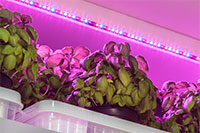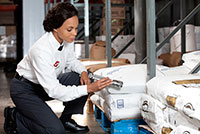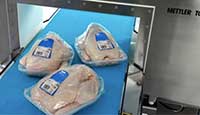Hollywood Dystopia Mirrors Beginning of Food Crises We Already See Today
By Allie Gallant
The 2014 movie Interstellar is set in the not-too-distant future. The world has become an increasingly uninhabitable dust bowl, and agriculture is reduced to a monoculture of one of the few crops that can survive, corn. It’s a bleak situation. So hopeless, that the movie’s heroes set out not to fix the world, but to find a new habitable one somewhere else in the universe.
Moving the entire human race to a distant galaxy is definitely in the realm of science fiction. But changing weather patterns, soil degradation and water shortages are not. The world is already experiencing profound hardship. As resources become increasingly scarce, the pressure to find a sustainable solution that solves our water woes builds.
So where does the future of agriculture lie? Indoor facilities, like one in Japan, may hold the answer.
Water, Water Everywhere – and Not a Drop to Spare
Water is a renewable resource. But that doesn’t mean its use is unlimited. There’s as much water on the planet as ever, but less than 1% of it is actually available to us in freshwater form. The other 99% is locked in polar icecaps or in the ocean. It’s also not uniformly available – 10 countries have 60% of the world’s freshwater supply.
National Geographic recently conducted a fascinating interview with Shigeharu Shimamura, a plant physiologist and CEO of Mirai. The company built an indoor production facility at a location in Japan that was devastated by a tsunami. The lights are designed to provide the optimal balance of cell growth and photo-synthesis. It produces 10,000 heads of lettuce a day. And, even more impressively, it uses less than 1% of the water required by traditional outdoor agriculture.
The plants grow under thousands of specialized LED lights developed by GE Japan. The lights are designed to provide the optimal balance of cell growth and photosynthesis, just enough to drive remarkable production without overcrowding the plants. Shimamura points out that the lights are also capable of providing “all other aspects necessary for plant growth,” a unique and cutting-edge development.
From a food safety perspective, indoor production has the potential to substantially decrease the risk of harmful bacteria making its way into produce. Even carefully-managed outdoor farms face risks beyond their operators’ control, including contamination from neighboring farms, shared water supplies and animals. Indoor farms are isolated environments, and as long as good food safety procedures are in place, they’re easier to keep bacteria-free at the production level. The ability to keep the environment pest-free also means pesticides aren’t necessary.
In terms of food security, outdoor crops are at the mercy of the elements. Eliminating yield loss from drought, frost and cold temperatures is an important development, especially as global climates increasingly tend toward extremes.
Other small-scale versions of the plant factory are already in place and two more large factories are in the works in Hong Kong and Russia.
Reducing the Reliance on Global Food Supply Networks
Aside from saving massive amounts of water, which allows the precious resource to be used elsewhere, the factories help countries become more food independent in the face of geographical and environmental factors. Japan has had an interest in indoor produce facilities for about 50 years, stemming from a desire to lessen dependence on imports. In parts of Russia, geographic remoteness and cold seasons limit access to fresh produce. And in Hong Kong, public concerns about food safety drive a strong demand to reduce reliance on imports and increase domestic production. Shortening the distance food needs to travel can also save on resources that would normally go toward transportation.
These indoor facilities expand the horizons of where and when food can be grown. However it’s still limited – as Shimamura points out, the factories rely on a dependable supply of electricity and water, and telecommunications infrastructure. Building capacity for renewable energy sources and bringing the internet to remote locations around the world is another piece of the puzzle.
Nurturing Food Systems on an Increasingly Stressed Planet
According to the United Nations, around 1.2 billion people, or almost one-fifth of the world’s population, live in areas of physical scarcity, with a further 500 million people approaching this situation. Currently, 36 countries face extremely high water stress.
Shimamura describes some of the motivation behind the factory in Japan: “The reason we chose this particular location is because we wanted to prove that vegetables can be produced anywhere now. Second, we wanted to help restart the economic development in this disaster area. And last, looking into the future, if we could succeed there, we could also see a possibility of exporting the technology we developed all over the world.”
The need to stretch scare resources farther will continue to drive innovation and research as we search for economical, practical ways to make the most of the planet we’ve got.
About the Author
Allie Gallant is regular freelance writer and blogger with Global Food Safety Resource who is also one of our most valuable and recognizable contributors.
To have more articles like this emailed to your inbox, become a GFSR Member today!

-
 FeaturedRisk management
The Cost of a Breach: What a Cyberattack Could Mean for Food Safety Recalls
FeaturedRisk management
The Cost of a Breach: What a Cyberattack Could Mean for Food Safety Recalls
-
 FeaturedRisk management
Securing the Food Chain: How ISO/IEC 27001 Strengthens Cybersecurity
FeaturedRisk management
Securing the Food Chain: How ISO/IEC 27001 Strengthens Cybersecurity
-
 FeaturedRisk management
Revolutionizing Food Safety Training: Breaking Out of the “Check-the-Box” Mentality
FeaturedRisk management
Revolutionizing Food Safety Training: Breaking Out of the “Check-the-Box” Mentality
-
 GFSI Standards
GFSI 2025: Building Trust, Tech-Forward Solutions, and Global Unity in Food Safety
GFSI Standards
GFSI 2025: Building Trust, Tech-Forward Solutions, and Global Unity in Food Safety
-
 FeaturedFood Safety
Integrated Pest Management: Strategies to Protect Your Brand’s Reputation
FeaturedFood Safety
Integrated Pest Management: Strategies to Protect Your Brand’s Reputation
-
 FeaturedFood Safety Culture & Training
No Open Door Policy: Challenges That Impact Pest Control in Food Processing Plants
FeaturedFood Safety Culture & Training
No Open Door Policy: Challenges That Impact Pest Control in Food Processing Plants




